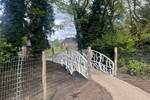SGL Carbon carbon fiber enables German road bridge milestone
A 64-meter road bridge installed with carbon fiber reinforcement is said to feature a first in modern European bridge construction, in addition to reducing construction costs and CO2 emissions.
Road bridge BW399c in Nuremberg. Source (All Images) | Hajo Dietz
The 64-meter-long road bridge BW399c, located along the A3 highway near Nuremberg, Germany, has been reinforced with SGL Carbon’s (Wiesbaden, Germany) 50K Sigrafil carbon fibers. The project, commissioned by (Berlin, Germany), has been awarded the bauforumstahl e.V. (Düsseldorf) German Steel Construction Engineering Award 2024.
Every 2 years, this award recognizes outstanding structures and highlights innovative bridge construction. The BW 399c bridge project, designed by engineering company Leonhardt Andrä und Partner, marks a significant milestone in modern bridge construction: An orthotropic composite roadway slab was used in combination with carbon fiber reinforcement on a road bridge, which is claimed to be a first in Europe.
Composite rebar used in the road bridge.
The method of using carbon fiber-reinforced concrete saved more than 60 tons of CO2 compared to conventional steel composite structures, SGL Carbon reports. Moreover, the weight of the roadway slab was reduced by 55%, bringing it down to just 450 kilograms per square meter. This lightened design also ensures a longer service life for the bridge due to carbon fiber’s corrosion resistance.
In addition, the reduced self-weight and prefabrication of bridge segments enabled an overnight installation, minimizing traffic disruptions on the busy A3 highway.
“This project combines several innovative approaches and demonstrates how the use of modern materials such as carbon [fiber] reinforcement can revolutionize bridge construction in the long term,” explains Tobias Mansperger, project manager and authorized signatory at Leonhardt Andrä und Partner.
Related Content
-
Plant tour: Teijin Carbon America Inc., Greenwood, S.C., U.S.
In 2018, Teijin broke ground on a facility that is reportedly the largest capacity carbon fiber line currently in existence. The line has been fully functional for nearly two years and has plenty of room for expansion.
-
Carbon fiber composite pallet revolutionizes freight industry
LOG Point Pallet fuses advanced materials with innovative design and manufacturing to improve supply chains worldwide.
-
Low-cost, efficient CFRP anisogrid lattice structures
CIRA uses patented parallel winding, dry fiber, silicone tooling and resin infusion to cut labor for lightweight, heavily loaded space applications.






